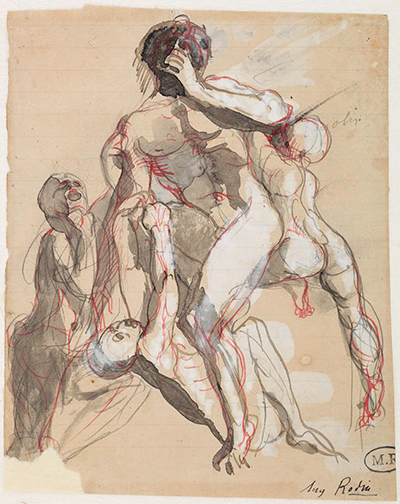In Ugolino Surrounded by His Three Children by Auguste Rodin (1840-1917) we see a male figure with a muscular body, posed together with three children, their spare anatomies in contrast to his bulk. The adult is covering his face with his hand, while his figure is hunched and tensed.
The children are reaching up to him in beseeching postures. Two of them reveal their faces, their features contorted with distress. The image raises questions in the mind of the viewer, the most immediate being to ask who the well-built man is and why do the apparently starving children cling to him? In 1880, Rodin received a commission to create a sculpture entitled The Gates of Hell, a scene from Dante’s Divine Comedy. As he did with all of his sculptures, Rodin made over 100 drawings in preparation for it and this image is one of them. Although the finished sculpture is very different from this drawing, an understanding of the artist’s methods of working is essential to interpreting it.
Rodin was a maker of portrait busts until he began to work upon allegorical and mythical subjects in the 1870’s. His earlier sculptures show the influence of Michelangelo, for example, The Age of Bronze (1877). Eventually, Rodin rejected the bulky, unrealistic musculature of the Renaissance artist in favour of sparer and more realistic subjects. Eventually, he eschewed naturalism and focused on expressing existential anguish and psychological intensity in his work by sculpting features contorted and limbs bent, twisted and fragmented. One example is The Clenched Hand (c. 1888).
In executing Ugolino, Rodin’s aim was not to produce a finished product, but capture the essence of the narrative he wanted to convey. The image depicts a scene from the tale of Ugolino, the Count imprisoned in the tower of Pisa and condemned to death by starvation alongside his children. In his agony, Ugolino contemplates eating the young people, a mood expressed by the hand drawn across his face. Executed in pencil, pen and ink, and gouache on paper, the strokes of the pen capture the mood of the subjects perfectly, with the heads and faces of the children emerging almost as skulls while the face of Ugolino is in darkness. The soft strokes of pencil suggest the motion of limbs writhing in agony at the horrible fates that await them.




